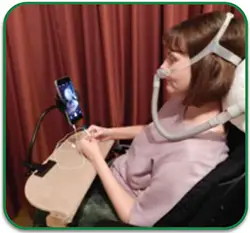
Touch Tap Swipe: an interactive guide
DMD Pathfinders have just published their latest 22 page interactive guide called Touch Tap Swipe. The guide explores how to choose and use a touch controlled smart phone or tablet, if you have minimal body movement. The guide was researched and written by members of DMD Pathfinders, all of whom are teenagers and adults living with Duchenne or a similar type of Muscular Dystrophy.
Louise Watch, DMD Pathfinder member, tells us more:
 When I went to university, I had my first mobile phone – an Ericson. To my weak arms it really gave meaning to the description ‘holding a brick’ and was for emergency use only. It was a lifeline – at least I could travel around campus on my own and speed dial my assistants to come and find me if I got stuck. It was both reassuring and sufficiently geeky for a student of the 90s!
When I went to university, I had my first mobile phone – an Ericson. To my weak arms it really gave meaning to the description ‘holding a brick’ and was for emergency use only. It was a lifeline – at least I could travel around campus on my own and speed dial my assistants to come and find me if I got stuck. It was both reassuring and sufficiently geeky for a student of the 90s!
As I became weaker, the technology, thankfully kept up. Phones became lighter and smaller, buttons easier to press and by the time I moved into my first house I could call assistants, text friends and play snake to keep myself entertained. With the phone on my lap I was able to yell out conversations on the good old Nokia 3310. It wasn’t exactly discrete… but I was keeping on top of the tech and reaping the social benefits.
I have a type of dystrophy, LG2C, which is similar to Duchenne in progression. Today I have minimal body movement. I can no longer press buttons, but I don’t need to as I can still move my finger across a touch screen that is under my hand – so my iPhone is pretty much glued to me.
A different story today
If I’d have had my iPhone at unversity, my assistants would have received a help beacon and map showing my geolocation. I wouldn’t have had to lift a finger as I could have used voice commands to ask Siri to do it for me. I wouldn’t have needed assistants to take notes during lectures they didn’t understand, or try to type my own on a laptop that was bigger than my current ventilator. Dictation and audio recordings converted to text would have clearly allowed more time socialising. My phone would have directed me to the pub and I’d have told Siri to update my Facebook status to make sure the world knew. I would already know there was an accessible toilet because I would have Googled that beforehand and taken a peek on Google Street View to check the route had no nasty suprises like a bumpy pavement or steps.
On arrival, if the evening was in full swing and I was too tired to physically speak – I could have typed out the words and had my phone say them out loud in my own voice, thus saving precious energy to continue socialising. How would I type if I couldn’t move my fingers – by telling my phone what to do using switches (switches convert an action you
can do, such as blinking or pressing a button, to a signal which your phone understands to make something happen). As the night went on, I could have asked Siri to take a picture of my meal (having mounted the phone on my chair with one of a range of clamps and stands) and posted it to Twitter #nomnom.
Whether it’s gaming, e-mailing, browsing the Internet, Tweeting, storing medical data, shopping, monitoring my health, socialising or using it as an emergency call button – I use my phone more than anything else. I’ve begun to do things I had lost the ability to do some 20 years ago – like take video/ photos and experience the pleasure of playing the piano again using GarageBand. My phone has made it possible and whether at home or out and about – I can Touch Tap and Swipe my way to a better life.
How the guide came about.
DMD Pathfinders is a user-led organisation which has a private Facebook group where
300 members living with Duchenne gather to chat. One conversation was concerning how to to use phones and tablets that relied on touch. Some people had never considered using one before whilst others used their devices all the time, sharing some great information. People were interested in finding out what was possible and so our guide
‘Touch, Tap, Swipe’ was formed to celebrate ‘The Promise of Technology’, this year’s theme for UN International Day of Disabled People.
“It’s totally opened up a whole world of communication and technology which was previously inaccessible to me.” Mark Chapman
Our interactive guide covers everything from choosing a phone/tablet through to holding and mounting solutions, accessibility features, detailed switch control information and product details (including where you can buy them from and the current price in the UK). Where available, we have also included 30+ product demonstrations on our YouTube channel playlist ‘Touch, Tap, Swipe’.
We hope that people with minimal body movement will discover the life enriching possibilities that smart phones and tablets can offer and discover new ways of controlling these devices.
The guide can be viewed on-line or downloaded from: DMD Pathfinder
By Louise Watch
Get in touch by messaging us on Facebook, tweeting us @DHorizons, emailing us at editor@disabilityhorizons.com or leaving your comments below.